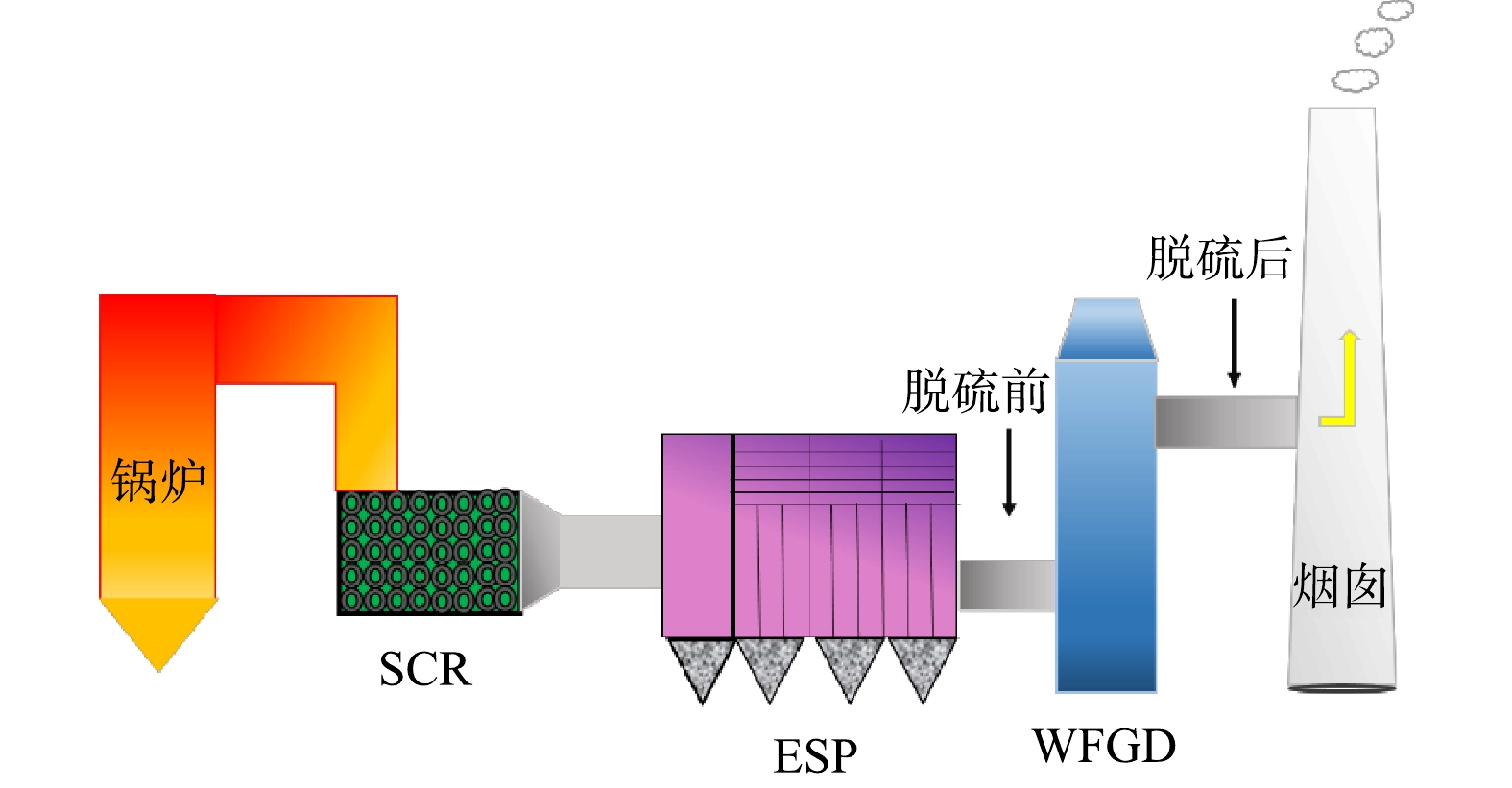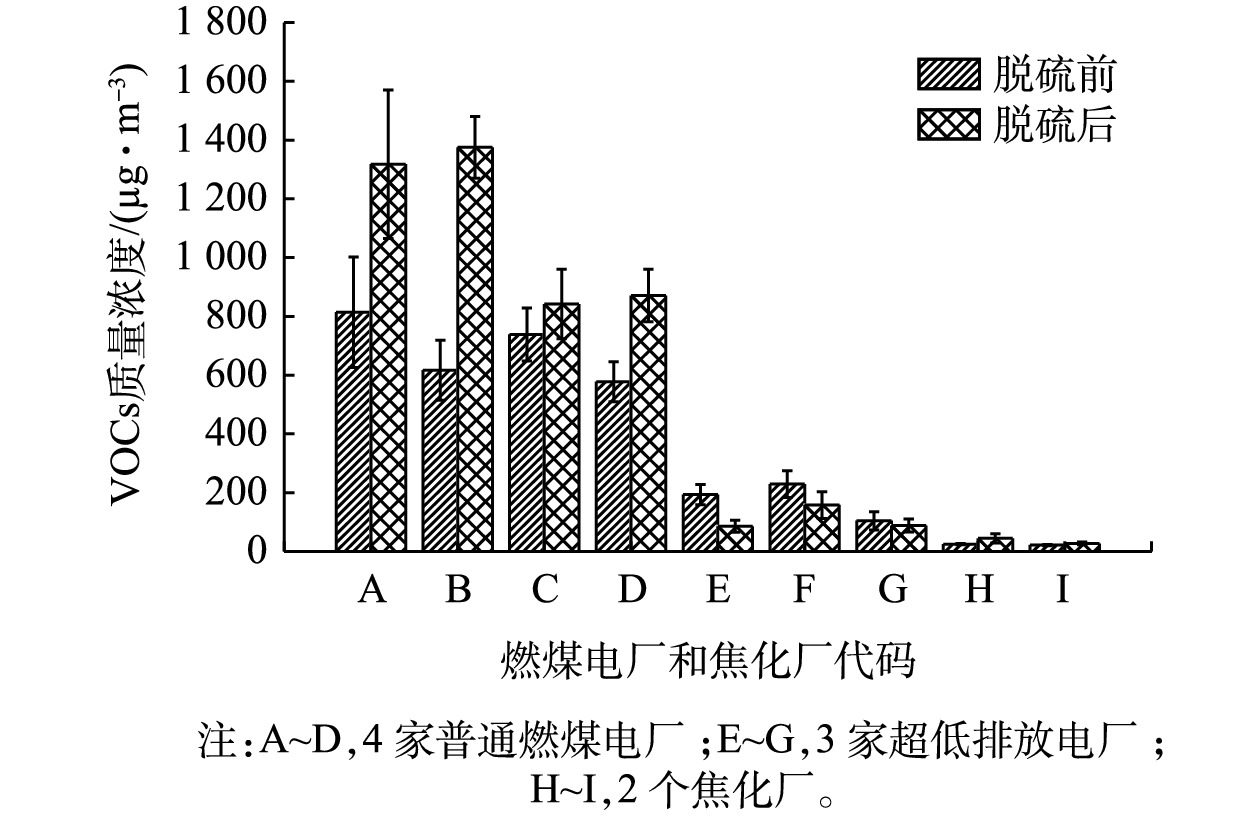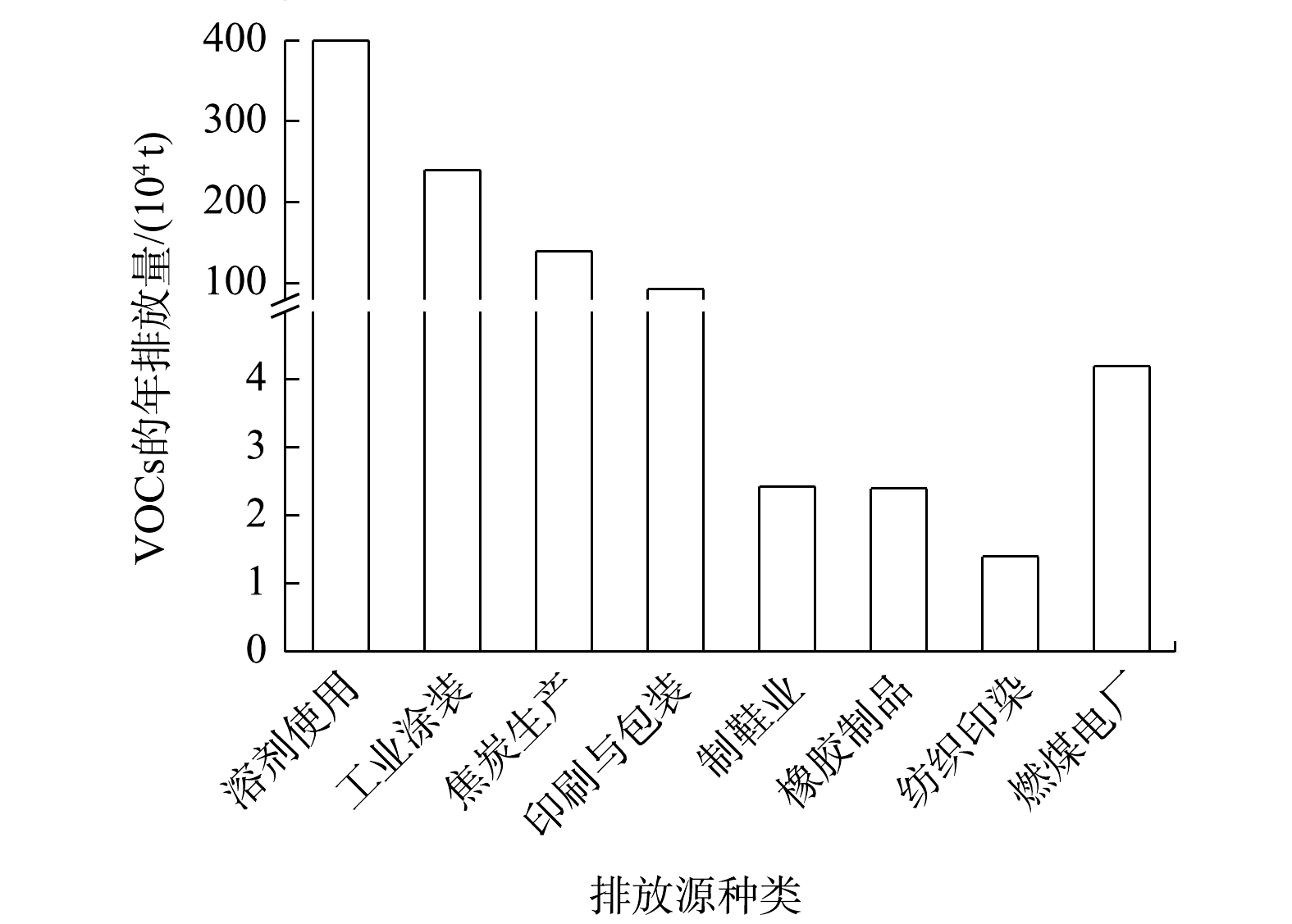-
2015年10月1日起,我国对挥发性有机物(volatile organic compounds, VOCs)的排放征收排污费。VOCs的排放控制已成为热点问题。VOCs是指在特定条件下具有挥发性的一类有机化合物,包括烷烃、烯烃、芳香烃、含氧有机化合物、卤代烃等,种类繁多[1]。部分VOCs具有毒性和致癌性,例如苯、二甲苯等对血液、肝脏等有毒害作用[2],二氯甲烷、三氯甲烷等会损伤人体神经中枢和内脏器官[3]。此外,在阳光下,VOCs还会与NOx、O3、·OH等强氧化物质发生光化学反应,形成光化学烟雾,造成大气环境二次污染[4-5]。近年来,O3已经成为我国某些特大城市的重要污染物[6],而VOCs还是O3的重要前体物,故减少VOCs的排放对遏制O3的增长有关键作用。
在我国,煤的燃烧是一个重要的VOCs人为排放源[7-8]。据统计,2017年我国燃煤发电行业的消耗煤炭量已达1.9×109 t,燃煤电厂耗煤量占煤炭总消耗量的49%;另外,我国现存燃煤工业锅炉约4.7×105余台,每年消耗标准煤7×108 t,约占全国全国煤炭消耗总量的20%[9]。燃煤过程排放的大量烟气中不仅含有SO2、NOx、PM2.5等污染物,也含有VOCs类有机物。VOCs主要包括苯、甲苯等苯系物,二氯甲烷、氯仿等卤代烃,以及醇、酮等含氧有机物[10-12]。因此,我国已出台相对严格的排放标准,督促燃煤企业完善污控设施,以控制污染物的排放。这些污控设施在减少SO2、NOx、尘等污染物排放的同时,对减少减少VOCs的排放也产生了积极影响[13-14]。
已有学者对脱硫前后VOCs的排放特征进行了研究[10, 15],但脱硫设施对VOCs和常规污染物的协同控制仍有未解决的问题。本研究中,通过对国内典型燃煤电厂锅炉和焦化厂燃煤锅炉的脱硫设施进出口的烟气中VOCs进行采样,考察脱硫设施控制不同种类VOCs的效果,为研究脱硫设施对2种燃煤锅炉排放VOCs的影响因素和协同控制机制提供参考。
全文HTML
-
随着经济发展和环保政策的有效实施,我国燃煤电厂600 MW及以上的装机容量正逐渐成为主流,约占国内燃煤电厂的39%[16]。燃煤电厂的污控设施不尽相同,其中90%以上的燃煤电厂采用湿法石灰石脱硫工艺[17]。近年来,越来越多的燃煤电厂开始进行超低排放改造,以进一步提升污控设施的污染物去除效率。本研究中,采集了国内7家典型燃煤电厂和2家焦化厂的相关数据(见表1)。相关企业分为3大类:A~D这4家燃煤电厂为普通燃煤电厂,采用选择性催化还原(selective catalytic reduction, SCR)技术去除NOx、静电除尘器(electrostatic precipitator, ESP) 除尘、湿法石灰石脱硫去除SO2;E~G 3家企业为超低排放电厂,采用SCR去除NOx,除尘设备为低低温静电除尘器(low-low temperature electrostatic precipitator, LLT-ESP)除尘,附加1套湿式静电除尘器(wet electrostatic precipitator, WESP),脱硫技术为脱硫效率更高的高效湿法石灰石脱硫法;H和I 为焦化厂,均采用选择性非催化还原(selective non-catalytic reduction, SNCR)技术脱硝、电袋除尘复合技术(Electrostatic-bag precipitator, EBP)除尘、氨法脱硫技术脱硫。
为研究脱硫设施对烟气中VOCs排放特征的影响,针对3种典型的脱硫工艺,即湿法石灰石脱硫、高效湿法石灰石脱硫、氨法脱硫,采集了9家工厂脱硫设施的进出口烟气数据及脱硫浆液和石膏的样品。烟气处理流程图及采样点如图1所示。
-
烟气样品采集依据《固定污染源废气 挥发性有机物采样 气袋法》(HJ 732-2014)进行。利用QC-1S大气采样仪(0.1~1.5 L·min−1,北京市科安劳保新技术公司)对烟气样品进行采集,样品用Teflon FEP气体取样袋(10 L,大连德霖气体包装有限公司)收集。采样流量为1 L·min−1,采气量10 L。采样结束后,气袋避光运输保存,并在5 d内完成实验室分析。
样品分析参考EPA TO-15的方法和文献[18-19],采用热脱附-气相色谱质谱法。分析仪器为QP2010GC-MS气相色谱-质谱仪(日本岛津公司),色谱柱为DB-5MS弹性石英毛细管柱(60 m×0.32 mm×1 μm),载气为高纯氦气,载气流量为1 mL·min−1。进样口温度为190 ℃。升温程序:40 ℃下保持2 min,然后以10 ℃·min−1升至180 ℃,再以40 ℃·min−1升至220 ℃,并保持4 min。采用电子轰击电离源,电离电压70 eV。定性定量采用选择离子模式,保留时间定性,内标法(4-溴氟苯、溴氯甲烷、氯苯-d5、1,4-二氟苯)定量。
实验拟检测的VOCs共64种,包括2种脂肪烃(异丁烯、正己烷)、14种苯系物(苯、甲苯、乙苯、间/对二甲苯、邻二甲苯、苯乙烯、异丙苯、丙苯、叔丁苯、1,2,4-三甲苯、1,3,5-三甲苯、丁苯、对异丙甲苯、仲丁苯)、24种卤代脂肪烃(氯乙烯、1,1-二氯乙烯、二氯甲烷、1,1-二氯乙烷、三氯甲烷、1,1-二氯丙烯、四氯化碳、1,2-二氯乙烷、三氯乙烯、1,2-二氯丙烷、溴二氯甲烷、顺-1,3-二氯丙烯、反-1,3-二氯丙烯、1,1,2-三氯乙烷、1,3-二氯丙烷、四氯乙烯、二溴氯甲烷、1,2-二溴乙烷、1,1,1,2-四氯乙烷、1,2,3-三氯丙烷、1,2-二溴-3-氯丙烷、六氯丁二烯、氯甲烷、溴甲烷)、9种卤代苯系物(氯苯、2-氯甲苯、4-氯甲苯、1,4-二氯苯、1,3-二氯苯、1,2-二氯苯、1,2,4-三氯苯、1,2,3-三氯苯、溴苯),萘,以及14种含氧VOCs(乙醇、丙酮、2-甲基丙烯醛、乙酸、甲酸甲酯、乙酸乙酯、乙酸丁酯、乙醚、乙腈、乙酸甲酯、丙醛、苯甲醛、1,4-二恶烷、二甲基-1,4-二恶烷)。
-
每个采样气袋在采样前均用高纯氮气清洗5次以上,抽真空保存。采样时,每个采样点取2个重复样品。在对样品进行检测时,每7个样品做一个全程序空白样品和空白加标样品。样品加标回收率为96%~110%,加标回收的相对偏差≤20%。各项指标均满足标准方法的要求。
1.1. 采样企业的信息
1.2. 样品的采集和分析
1.3. 质量保证与质量控制
-
图2反映了9家工厂脱硫前后的VOCs总质量浓度变化。由图2可知,各工厂尾气污染控制设施对VOCs的排放影响差别较大。根据表1的工厂尾气污染控制信息,可以分成3类,分别为:A~D,4家普通燃煤电厂(Ⅰ类);E~G,3家超低排放电厂(Ⅱ类);H~I,2个焦化厂(Ⅲ类)。这些工厂脱硫前排放的VOCs质量浓度分别为(687±94)、(176±52)、(23.3±1.6) μg·m−3,脱硫后排放的VOCs质量浓度分别为(1 102±246)、(111±34)、(35.9±8.7) μg·m−3。Ⅰ类厂脱硫设施进出口VOCs的质量浓度都远高于其他厂,而且脱硫设施出口VOCs质量浓度高于脱硫入口。上述数据说明,脱硫设施不仅没有实现VOCs减排,其质量浓度还增加了(62±39)%。Ⅱ类厂脱硫进出口VOCs的质量浓度均较低,脱硫设施对VOCs的去除率达到(34±16)%。Ⅲ类厂脱硫进出口VOCs的质量浓度均最低,脱硫设施没有显示出对VOCs的去除效果,VOCs的质量浓度增加了(52±27)%。
Ⅱ类厂排放VOCs的质量浓度低于Ⅰ类厂,原因是Ⅱ类厂采用了超低排放技术。尾气在低低温静电除尘和湿电除尘综合作用下,VOCs等污染物均得到了控制。同时,采用了高效湿法石灰石脱硫技术,并通过增加均流提效板、将脱硫设施中的喷淋方式改为交互式喷淋等措施提升了对SO2的脱除效率。另外,随着系统液气比的增加,增进了脱硫浆液与烟气的接触,有助于SO2和VOCs的协同减排[20]。Ⅲ类厂为焦化厂锅炉,该锅炉的吨位、温度和压力等都小于燃煤电厂锅炉,尾气设施采用了去除污染物效率更高的电袋复合除尘器,排放的VOCs等污染物质量浓度很低[21]。
-
燃煤电厂的机组容量、污控设施的种类、焚烧效率、脱硫浆液等因素均会影响烟气中污染物的质量浓度。在Ⅰ类厂中,A、B、C均为300 MW左右的锅炉,D厂为600 MW的锅炉。A~D厂脱硫后(即总排口)VOCs的质量浓度分别为1 317.8、1 374.9、842.3、871.2 μg·m−3,表明D厂浓度明显小于A、B两厂,这是由于D厂机组容量大,锅炉燃烧工况稳定,燃烧充分;而C厂VOCs的质量浓度也远低于A、B两厂,这可能与机组负荷率有关,A、B、C 3个厂的机组负荷率分别为66%、63%、70%;其中C厂实际负荷高,但排放VOCs的质量浓度低,说明锅炉高负荷可保证燃烧充分,故排放VOCs的质量浓度也较低,这与LIU等[22]的研究结论一致。
此外,脱硫石膏和脱硫浆液会改变VOCs的气固相分配,从而影响VOCs的排放。VOCs普遍挥发性较高,许多组分不溶或难溶于水,不容易被脱硫浆液溶解或被脱硫石膏吸附。脱硫循环水的使用也可能是影响VOCs去除的关键因素。VOCs经过脱硫设施后质量浓度增加,可能是因为燃煤电厂脱硫水的多次循环使用造成了污染物在循环水中的积累和二次释放[23]。MEIJ等[24]测定了新西兰某燃煤电厂排放烟气中的元素组成,结果表明烟气中50%的污染物来自于石灰石-石膏脱硫浆液。本研究中测定了A厂脱硫浆液和石膏样品中VOCs的质量浓度,脱硫浆液中VOCs的质量浓度为(4.4±1.7) μg·L−1, 石膏中VOCs的质量分数为(73.2±27) ng·g−1。这说明VOCs在脱硫处实现了从气相到固液相的转移,但也说明脱硫浆液的循环使用可能会影响VOCs的去除。因此,为提高脱硫的协同减排效率,脱硫循环水应针对VOCs等有机物增加必要的净化去除措施,如喷雾蒸发处理技术、化学沉淀法等,均可用来去除脱硫浆液中的污染物[25]。
-
脱硫设施中的副产物脱硫废水和石膏会对VOCs的质量浓度产生较大影响。而且对大部分燃煤电厂来说,脱硫是整个烟气处理流程的最后一步,即经过脱硫处理后的烟气直接排放到大气中,因此,研究脱硫设施对VOCs的影响具有重要意义。将燃煤电厂和焦化厂排放的64种VOCs分成6大类,分别为脂肪烃、卤代脂肪烃、苯系物、卤代苯系物、含氧VOCs、萘。图3展示了VOCs脱硫后比脱硫前的比值,若比值大于1,说明脱硫后VOCs的质量浓度增加,反之说明脱硫后VOCs的质量浓度有所降低。
由图3可知,脱硫设施对不同种类VOCs的排放影响区别较大。部分工厂脱硫设施出口处脂肪烃、卤代脂肪烃、苯系物和萘的浓度升高。这可能是由于脂肪烃、苯系物等属于易挥发的小分子化合物,而苯系物和卤代烃的−lg Sw (Sw为溶解度)范围是1.64~6.98[26],属于疏水化合物,在脱硫设施中以气相形式存在。相比之下,脱硫设施对卤代苯系物、含氧VOCs有相对较好的去除效果,去除率分别为21.5%、29.8%。其原因是卤代苯系物属于大分子化合物,在脱硫过程中会随着脱硫石膏或脱硫循环水被带走。含氧VOCs质量浓度降低是由于含氧VOCs中的羟基、羧基、羰基等均属于亲水基团,在脱硫过程中会从烟气转移到脱硫循环水中。CHENG等[10]在研究超低排放燃煤电厂污控设施对VOCs影响的研究中也指出,脱硫主要通过“水洗”作用来降低VOCs的质量浓度,这也验证了本研究的结果。
-
苯系物是燃煤锅炉最常见的VOCs。将本研究中苯系物(苯、甲苯、间/对二甲苯、邻二甲苯、苯乙烯)的排放情况与文献报道的结果对比(见表2)发现,同一物种在不同燃煤锅炉排放的质量浓度存在差异,导致差异的原因可能是燃煤种类、锅炉类型、污控设施等的不同。此外,表2中数据再次证明了焦化厂(Ⅲ类厂)排放VOCs的质量浓度低于其他厂。3类厂中间/对二甲苯、邻二甲苯、苯乙烯的质量浓度均低于已有的文献报道[27-29],属于低水平排放。而且,3类厂中Ⅰ类厂苯和甲苯的质量浓度最高,苯的质量浓度与文献[28]相似,甲苯的质量浓度与文献[27]相似且略高。其中,A厂贡献较大,这可能与A厂的燃煤温度、污控技术的选择等有关。
-
化学反应活性是指某一有机物通过化学反应生成产物的能力。VOCs的化学反应活性可通过其对臭氧生成的贡献来评价,即臭氧生成潜势(ozone formation potential,OFP)[30-31],计算方法见式(1)。
式中:OFPi为某种VOCs的臭氧生成潜势,μg·m−3;Ci为VOCs物种的质量浓度,μg·m−3;MIRi为VOCs物种的MIR系数,取自文献[32]。
各企业脱硫后不同种类VOCs的OFP占比如图4所示。3类企业的OFP平均值分别为(715.6± 1 111.9)、(225.9±31.6)、(31.2±14.4) μg·m−3,即苯系物对臭氧生成的贡献最大。在部分样品中,脂肪烃和卤代脂肪烃也具有较高的贡献。这是由于尽管苯系物的质量浓度偏低,但是MIR系数高,对臭氧的生成贡献大。甲苯为3类企业中OFP值最高的物种,其OFP值分别为(547.7±923.5)、(102.9±70.1)、(12.4±4.5) μg·m−3,占总OFP值的40%~77%。此外,苯、间/对二甲苯、邻二甲苯、乙腈等的OFP值也较高。GENG等[33] 的研究结果表明,某生物质锅炉排放VOCs的OFP优势物种为苯系物和脂肪烃,与本研究结果基本一致。还有研究结果表明,珠江三角洲的VOCs人为排放源排放的VOCs中芳香烃和烯烃在OFP中贡献较大,高于其排放质量浓度的贡献[34]。因此,在关注高质量浓度VOCs的同时,也不能忽略对臭氧生成贡献较大的VOCs物种。
-
排放因子法是估算燃煤锅炉排放量的常见方法,排放因子的计算方法见式(2)。
式中:EFcoal为以单位煤消耗量计算的VOCs排放因子,g·GJ−1;CVOCs为燃煤锅炉排放的VOCs的质量浓度,μg·m−3;Vflue gas为燃煤锅炉排放的烟气量,m3·h−1;M为耗煤量,kg·h−1;H为煤的热值,kJ·kg−1。
7家燃煤电厂VOCs平均质量浓度为(677±524) μg·m−3。已有研究结果表明,燃煤电厂排放VOCs的质量浓度为250~1 400 μg·m−3[15, 35-36],各研究中VOCs的质量浓度处于近似范围,据此计算的排放因子具有一定代表性。燃煤电厂VOCs排放因子为0.23~4.51 g·GJ−1,平均值为2.37 g·GJ−1。2018年,我国火力发电量为49 794.7×108 kW·h,计算出燃煤电厂VOCs的年排放量为4.2×104 t。KLIMONT等[37]计算了燃煤电厂排放的非甲烷总烃的排放因子,为1.5 g·GJ−1,略低于本研究计算的64种VOCs的排放因子。此外,YAN等[38]研究得到燃煤电厂VOCs的排放因子为0.88 g·GJ−1,也低于本研究的结果,这可能是由于其锅炉燃烧效率高且煤质较好。然而,文献[37-38]报道的排放因子均在7家电厂的排放因子范围内。此外,将燃煤电厂的VOCs年排放量与其他几种典型的工业排放源作比较[39-40],结果如图5所示。其中,溶剂使用、工业涂装、焦炭生产等企业VOCs的年排放量较高,可达1×106 t以上。燃煤电厂VOCs的年排放量虽然在工业源中贡献较低,但高于制鞋业、纺织印染、橡胶制品等行业。
2.1. 脱硫工艺前后VOCs质量浓度的变化
2.2. 影响VOCs排放的因素
2.3. 燃煤电厂脱硫前后VOCs的排放特征
2.4. 本研究中苯系物的排放情况与文献报道的对比分析
2.5. VOCs的化学反应活性评估
2.6. VOCs的排放量估算及与各行业排放量对比
-
1)燃煤电厂的脱硫设施对VOCs的减排作用并不明显。在进行脱硫之后,燃煤电厂和焦化厂的锅炉烟气中VOCs的质量浓度反而增加。一是由于脱硫废水和脱硫石膏影响了体系的气固相分配,从而影响了VOCs的吸收;二是VOCs本身不溶或难溶于水,不易被脱硫浆液溶解或被脱硫石膏吸附,故燃煤电厂脱硫水的多次循环使用也造成了VOCs在循环水中的积累和二次释放。
2)超低排放燃煤电厂使用高效湿法石灰石脱硫技术。该类电厂排放烟气中VOCs的质量浓度低于普通燃煤电厂,脱硫设施也呈现了较好协同减排效果。说明该技术不仅能有效去除常规污染物,也可去除一定量的VOCs,可在燃煤电厂行业推广。
3)各企业的OFP为17~2 640 μg·m−3。无论在普通燃煤电厂、超低排放电厂,还是焦化厂中,苯系物的质量浓度均不是最高的,但对臭氧的生成贡献却最大。
4)燃煤电厂的排放因子为2.37 g·GJ−1。燃煤电厂VOCs排放因子受到多种因素影响,还需结合采样结果不断完善其计算方法。VOCs的年排放量为4.2×104 t,对于工业源的贡献虽然低于溶剂使用等VOCs高排放企业,但高于纺织印染、橡胶制品等行业,因此,燃煤电厂对VOCs排放的贡献不容忽视。




 下载:
下载:





